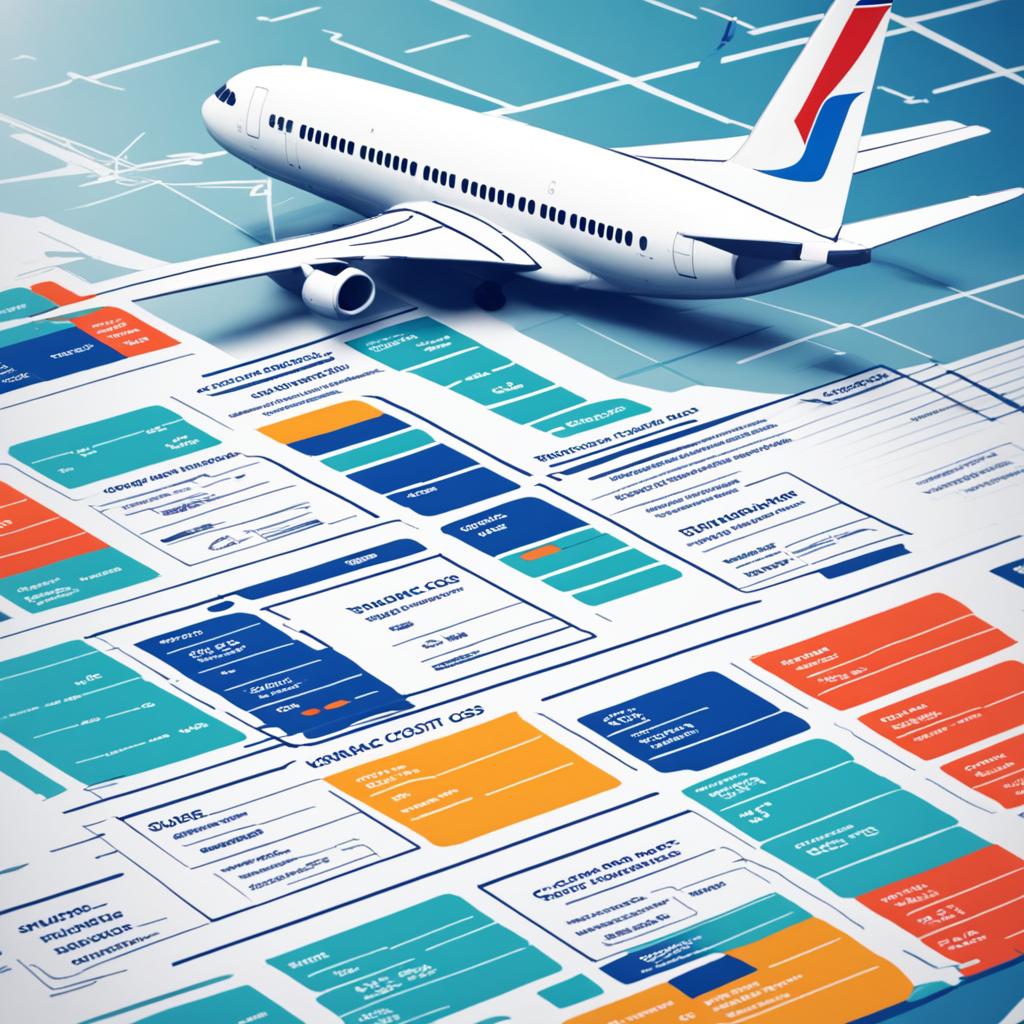Have you ever wondered how airlines determine their financial health? What percentage of seats do they have to fill to cover their operating expenses? The answer lies in the break-even load factor, a critical metric that directly impacts their profitability and viability.
But what exactly is the break-even load factor for airlines? The break-even load factor refers to the average percentage of seats that must be filled on an average flight at current average fares for an airline to cover its operating expenses. It serves as a benchmark for airlines to assess their financial viability and make informed decisions about their operations.
In recent years, most large passenger airlines have experienced a significant increase in their break-even load factors. Some carriers have even struggled to cover their operating expenses, even when selling 100% of their seats at average airfares. So, what factors contribute to this phenomenon? And how does it impact the overall financial health of airlines?
In this article, we will explore the factors affecting the break-even load factor, the impact of bankruptcy on the load factor, and the importance of this metric for airline performance and recovery. We will also discuss the role of route selection and the load factor as an indicator of an airline’s recovery post-pandemic.
So, if you’re curious to learn more about the break-even load factor and its significance in the airline industry, keep reading!
Factors Affecting the Break Even Load Factor

The break even load factor (BLF) of an airline is influenced by two key factors: passenger yield and unit costs. Passenger yield refers to the revenue generated per revenue passenger-mile, while unit costs represent the operating expenses incurred per available seat-mile.
A decline in passenger yield and an increase in unit costs can both contribute to a higher BLF. When passenger yield decreases, it means that the airline is generating less revenue for each mile traveled by a passenger. Similarly, when unit costs rise, it indicates that the airline is incurring higher expenses for each available seat-mile.
For many large passenger airlines, unit costs have been steadily increasing, especially for those already facing financial risks. This trend further adds to the challenges of maintaining a low BLF and achieving profitability.
To summarize, the BLF is influenced by passenger yield and unit costs, with a decrease in yield and an increase in costs contributing to a higher BLF. Let us now analyze how these factors impact the financial health of airlines.
| Factors | Impact on BLF |
|---|---|
| Passenger Yield | A decline in passenger yield leads to an increase in BLF. |
| Unit Costs | An increase in unit costs raises the BLF. |
Impact of Bankruptcy on the Break Even Load Factor

Airlines that have recently filed for bankruptcy, such as United Airlines and US Airways, have experienced a significant increase in their Break Even Load Factor (BLF). In the first quarter of 2000, the BLF for the recently bankrupt group was 77.7%, but it rose to 114.0% in the first quarter of 2003. This increase in the BLF indicates the financial challenges faced by these airlines. Even if these airlines filled every seat, they would not have generated enough revenue to cover their operating expenses. On the other hand, the BLF for the profitable group has remained below 70%.
This data is based on information from the Bureau of Transportation Statistics, highlighting the impact bankruptcy can have on an airline’s financial health. Bankruptcy disrupts the stability of an airline’s operations, leading to a higher BLF as they struggle to cover their expenses.
| Bankrupt Airlines | BLF Q1 2000 | BLF Q1 2003 |
|---|---|---|
| United Airlines | 77.7% | 114.0% |
| US Airways | 77.7% | 114.0% |
The table above illustrates the increase in the BLF for United Airlines and US Airways, demonstrating the impact of bankruptcy on the financial performance of these airlines.
Passenger Yield and the Break Even Load Factor

The decline in passenger yield has had a significant impact on the break even load factor (BLF) for airlines, especially for recently bankrupt carriers. However, it is important to note that passenger yield has also declined for most large carriers across the industry. The decrease in passenger yield between the first quarter of 2000 and the first quarter of 2003 has contributed to the increase in the BLF for airlines in the recently bankrupt group.
Passenger yield refers to the revenue generated per revenue passenger-mile. A decrease in passenger yield means that airlines are generating less revenue from each mile flown by a passenger. This decline in revenue has put additional pressure on the already strained financial situation of recently bankrupt carriers, making it more challenging for them to reach their break even point.
It is important for airlines to closely monitor their passenger yield and take proactive measures to address the decline. By focusing on strategies to improve passenger yield, airlines can aim to reduce their overall BLF and improve their financial performance.
This analysis is based on data from the Bureau of Transportation Statistics and a Forbes analysis, which highlight the link between passenger yield and the break even load factor for both recently bankrupt carriers and the wider industry.
- The decline in passenger yield has impacted recently bankrupt carriers.
- Most large carriers have also experienced a decline in passenger yield.
- The decrease in passenger yield has contributed to an increase in the BLF for recently bankrupt airlines.
- Airlines must monitor passenger yield and employ strategies to mitigate the decline for improved financial performance.
Unit Costs and the Break Even Load Factor
When it comes to determining the break even load factor (BLF) for airlines, unit costs play a crucial role. Unit costs refer to the expenses incurred by an airline for operating each available seat-mile. For large airlines that are facing financial risks, their unit costs tend to be higher compared to other airlines. What’s more, these costs have been steadily rising in recent years.
It’s interesting to note that while the recently bankrupt and at-risk groups of airlines have experienced a significant increase in unit costs, the profitable group has managed to keep them relatively stable. This contrast highlights the financial challenges faced by airlines in the former groups and raises concerns about their long-term sustainability.
Although cost-cutting initiatives have been implemented by airlines in the recently bankrupt and at-risk groups, there is often a lag between the implementation of these initiatives and their actual impact on unit costs. As a result, the full benefits of these cost-cutting measures have yet to be realized.
Understanding the relationship between unit costs and the break even load factor is crucial for airlines in managing their financial health. By controlling and reducing unit costs, airlines can achieve a lower BLF, which in turn helps to improve profitability and ensure long-term success.
Factors Influencing Unit Costs
Several factors contribute to the rise in unit costs for airlines:
- Increasing fuel prices
- Higher maintenance and repair expenses
- Growing labor and staffing costs
- Escalating regulatory compliance expenses
These factors, combined with other operational overheads, put additional pressure on airlines to optimize their cost structures and find ways to improve efficiency without compromising safety or service quality.
Importance of the Break Even Load Factor for Airlines
The load factor is a critical metric for airlines as it directly impacts their performance and financial success. It refers to the percentage of seats filled on flights, and a higher load factor signifies greater success in selling seats and increasing revenue. Maximizing the load factor is a key objective for airlines as it contributes to their overall financial health.
The break even load factor serves as a benchmark for airlines to determine their financial viability. It represents the minimum load factor airlines need to achieve to cover their operating expenses. By surpassing this breakeven point, airlines can generate profits and ensure long-term sustainability.
With intense competition in the airline industry, maintaining a high load factor is crucial. Airlines employ various strategies to drive demand and increase their load factors, including effective revenue management, marketing campaigns, and customer loyalty programs. By continuously monitoring and optimizing their load factors, airlines can enhance their financial performance and gain a competitive edge.
Image:
Role of Route Selection on the Break Even Load Factor
Route selection is a critical factor in determining the load factor and profitability of airlines. Extensive research and analysis are conducted to assess the potential profitability of a route before it is launched. Airlines carefully consider factors such as market demand, competition, and operational feasibility when selecting routes.
Once flights commence on a particular route, the load factor becomes a key metric for evaluating the route’s success. The load factor measures the percentage of seats filled on average flights. It provides valuable insights into passenger demand and the route’s financial performance.
Airlines closely monitor the load factor for each route and make informed decisions based on the data. Routes with consistently low load factors may be considered underperforming and could be canceled or reallocated to more profitable destinations. On the other hand, routes with high load factors indicate strong passenger demand and may prompt airlines to increase the frequency of flights or upgrade to larger aircraft to accommodate more passengers.
The profitability of a route is closely tied to its load factor. Higher load factors contribute to increased revenue and improved financial performance for airlines. By selecting routes strategically and optimizing load factors, airlines can enhance their overall profitability and financial health.
| Route | Load Factor | Profitability |
|---|---|---|
| New York to Los Angeles | 85% | Highly Profitable |
| Chicago to Miami | 70% | Reasonably Profitable |
| Houston to Denver | 55% | Marginally Profitable |
The table above illustrates the relationship between load factors and profitability for different routes. Higher load factors generally correspond to a higher level of profitability, while lower load factors may indicate challenges in achieving satisfactory financial results.
By considering the role of route selection in optimizing load factors and profitability, airlines can make informed decisions that contribute to their overall success and sustainability.
Load Factor as an Indicator of Recovery
Monitoring the load factor has become crucial for airlines as they navigate the path to recovery in a post-pandemic world. The load factor serves as an essential indicator of an airline’s progress in reviving their operations. By closely analyzing the load factor, airlines gain valuable insights into passenger demand and the effectiveness of their recovery efforts.
A higher load factor signifies a significant milestone for airlines – increased passenger confidence and willingness to travel again. As more passengers fill the seats, it not only generates crucial revenue for airlines but also signals a positive trajectory towards normalcy. Comparing current load factors to pre-pandemic levels allows airlines to gauge their progress in reclaiming passenger volumes.
The load factor plays a critical role in tracking an airline’s recovery journey. As the industry strives to regain stability, airlines recognize the load factor as an authoritative measure of their financial health and resilience. By continuously monitoring the load factor, airlines can adapt their strategies and tailor their offerings to meet evolving passenger needs, ensuring a successful post-pandemic recovery.
FAQ
Q: What is the break even load factor for airlines?
A: The break even load factor (BLF) is the average percentage of seats that must be filled on an average flight at current average fares for an airline to cover its operating expenses.
Q: What factors affect the break even load factor?
A: The break even load factor is determined by two main variables: passenger yield and unit costs. Passenger yield refers to the revenue per revenue passenger-mile, while unit costs represent the operating expenses per available seat-mile.
Q: How does bankruptcy impact the break even load factor?
A: Airlines that have recently filed for bankruptcy have experienced a significant increase in their break even load factor. Even if these airlines filled every seat, they would not have generated enough revenue to cover their operating expenses.
Q: How does passenger yield affect the break even load factor?
A: The decline in passenger yield has contributed to the increase in the break even load factor for airlines. Passenger yield has fallen between the first quarter of 2000 and the first quarter of 2003.
Q: What role do unit costs play in the break even load factor?
A: Unit costs play a significant role in determining the break even load factor for airlines. Large airlines at financial risk have higher unit costs compared to other airlines, and these costs have been rising over time.
Q: Why is the break even load factor important for airlines?
A: The break even load factor serves as a benchmark for airlines to determine their financial viability. Airlines strive to maximize their load factor as it directly impacts their financial health and success.
Q: How does route selection affect the break even load factor?
A: Route selection plays a crucial role in determining the load factor and profitability for airlines. Extensive research is conducted to assess the potential profitability of a route before it is launched.
Q: How does the load factor indicate airline recovery?
A: Monitoring the load factor provides insights into passenger demand and the success of an airline’s recovery efforts. A higher load factor signifies increased passenger confidence and willingness to fly.
